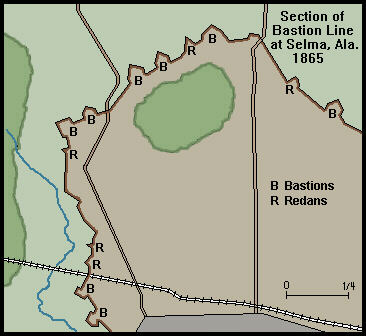Civil War Field Fortifications
Bastion Lines
A bastion was a field work very much like a lunette that
consisted of two faces that formed a salient angle and two flanks that connected
to curtains which were more or less straight stretches of parapet and ditch
to form strong re-entering angles.
 A
bastion's flanks were positioned to project columns of fire across the faces
of collateral bastions which crossed the columns of fire projected by both
the curtain between bastions and collateral bastions' faces. Bastion lines
combined a series of bastions and curtains to form a continuous line of works.
Each line of defense, or distance from the re-entering angle formed by the
joint of a flank and curtain to the capital of the salient angle of a collateral
bastion, was supposed to be no more than 160 yards long so that the entire
line would be covered by close range small arms fire.
A
bastion's flanks were positioned to project columns of fire across the faces
of collateral bastions which crossed the columns of fire projected by both
the curtain between bastions and collateral bastions' faces. Bastion lines
combined a series of bastions and curtains to form a continuous line of works.
Each line of defense, or distance from the re-entering angle formed by the
joint of a flank and curtain to the capital of the salient angle of a collateral
bastion, was supposed to be no more than 160 yards long so that the entire
line would be covered by close range small arms fire.
Complete bastion lines were rarely constructed during the
Civil War. Though this type of line projected the most thorough network of
crossing columns of fire of any of the line forms, like tenaille lines, bastion
lines required a certain refined degree of geometrical symmetry that was
difficult to achieve in the field over an extended position. Again like tenaille
lines, bastion lines required greater depth of ground than other forms of
lines and consequently required relatively more troops to adequately defend
the parapet. Most manuals tended to emphasize the difficulty of properly
laying out a series of bastions and the extra time, labor, and materials
necessary to construct the bastions when compared to indented or redan lines.
A bastion, for example, required five separate angles, two re-entering and
three salient, where a redan required three (one salient, two re-entering)
and a cremaillere only required one salient and one re-entering angle for
each complete field work within the line. These limitations usually
 restricted
the use of bastions to important and appropriate points within lines that
included other forms of field works.
restricted
the use of bastions to important and appropriate points within lines that
included other forms of field works.
One of the best examples of the use of multiple bastions
within a continuous line occurred in the Confederate defenses of Selma, Alabama.
But in this case the profile of the line was very weak with a shallow ditch
and low parapet that amounted to little more than an average rifle pit. Selma's
bastions, which were combined with redans to allow crossing columns of fire,
inhibited the defense of the line when it was attack by Federal cavalry in
1865 by requiring more troops for a good defense than the Confederates could
gather. Though the trace of Selma's defensive line seems to have been quite
effective, in an abstract sense, its length and profile actually prevented
the Confederates from concentrating their small garrison for a sound defensive
effort while their weak profile opposed the Federal attack with an insignificant
obstacle.
Note: Lunettes and bastions basically had the same shape: two faces
and two flanks. Lunettes are distinguished from bastions by their use as
detached works or as retired elements in continuous lines.
Back to Lines
Redan Lines
Tenaille Lines
Cremaillere Lines
Lines with Intervals
Contents Home
Page Major Works
Minor Works
Siege Works
Permanent Fortifications
Glossary
Copyright (c) PEMcDuffie 1998
 A
bastion's flanks were positioned to project columns of fire across the faces
of collateral bastions which crossed the columns of fire projected by both
the curtain between bastions and collateral bastions' faces. Bastion lines
combined a series of bastions and curtains to form a continuous line of works.
Each line of defense, or distance from the re-entering angle formed by the
joint of a flank and curtain to the capital of the salient angle of a collateral
bastion, was supposed to be no more than 160 yards long so that the entire
line would be covered by close range small arms fire.
A
bastion's flanks were positioned to project columns of fire across the faces
of collateral bastions which crossed the columns of fire projected by both
the curtain between bastions and collateral bastions' faces. Bastion lines
combined a series of bastions and curtains to form a continuous line of works.
Each line of defense, or distance from the re-entering angle formed by the
joint of a flank and curtain to the capital of the salient angle of a collateral
bastion, was supposed to be no more than 160 yards long so that the entire
line would be covered by close range small arms fire.
 restricted
the use of bastions to important and appropriate points within lines that
included other forms of field works.
restricted
the use of bastions to important and appropriate points within lines that
included other forms of field works.